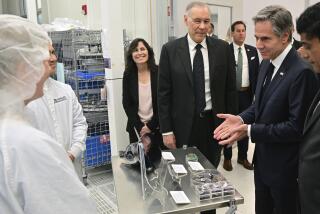Supercomputer Centers Calling Out to Corporations
Larry Smarr, the director of the University of Illinoisâ National Center for Supercomputing Applications, suggested that corporate America follow George Washingtonâs lead.
âWhen Washington got to the Delaware, he couldnât wait three months for a break in the weather,â said Smarr, who has been prodding corporations to look beyond the next fiscal quarter and join in an âhistoric quantum jumpâ into the supercomputing world of the 1990s.
âItâs a time for leadership, a time for vision,â Smarr said during a recent interview. âWeâre going to find out if corporate America has the stuff to meet the challenge.â
Smarr has issued a lofty challenge. He wants eight diverse industrial corporations--each with $1-million checks in hand--to join the National Science Foundation-funded center at Champaign-Urbana.
And, he wants them to make a commitment within six months: âThatâs the window of opportunity for corporate America, and I hope for the good of all that we can work it out.â
Also out beating the corporate bushes is Robert Randall, manager of resource development for the San Diego Supercomputer Center, which hopes to bolster its NSF-funded research by adding $40 million during the next five years.
âThere are nights when I wake up in a cold sweat, wondering where Iâm going to get $40 million,â said Randall, who said he is âconfidentâ that the âtall orderâ can be accomplished.
The added money would allow the San Diego center to replace its initial supercomputer. âAs bigger and better supercomputers become available, weâd make them available to the research and academic communities,â Randall said.
That is the same plan that Smarr has developed at the Illinois center.
However, the centers are not merely turning to corporate coffers for a handout.
Corporations that contribute $1 million annually to the Illinois center will be invited to send their âsenior researchers, the guys who might have 100 people under them and millions of dollars of computer equipment,â to the Illinois center, Smarr said. Once on campus, the corporate scientists will work shoulder-to-shoulder with university researchers who are fine-tuning one of the worldâs most powerful computers.
âThere is a revolution about to take place in the Fortune 1,000,â said William Schrader, executive director for the Center for Theory and Simulation in Science and Engineering at Cornell University. Schrader, a biologist by training, has been spending half of his day courting companies âlike Corning, Kodak, General Electric, General Motors, Dupont and Exxon . . . the kind of people who are knowledgeable about what the computing environment of the 1990s will require.â
Those companies âall will need large-scale supercomputing to stay competitive worldwide, and while we wonât teach them how to do it, we will develop a 1990s environment ahead of time,â said Schrader, who wants 30 companies to each contribute a minimum of $100,000 annually.
Although the San Diego center has identified a minimum level of corporate involvement, it has not made that level public, said Director Sidney Karin, who added that âwe would like to remain flexibleâ enough to encourage various kinds of research arrangements with corporations.
That arrangement would help the 19-member consortium that is helping finance the center âget closer togetherâ with industry, said Karin, who added that âthere are things that each group can learn from each other.â
Smarr is confident that industry soon will recognize that the four supercomputing centers (at Cornell University; San Diego; Princeton, N.J., and Champaign-Urbana) provide an alternative to âcostly (research) duplication that is an enormous drag on the nationâs productivity,â Smarr said.
A physicist by training, Smarr explained that the same supercomputing research that gives him a better explanation of âhow gas flows around a black holeâ would also help answer the down-to-earth questions of industrial scientists who want to know âhow gas flows generate thunderstorms . . . how gas flows inside a turbine, or how gas flows around a car. The laws of gas dynamics are constant and universal.â
Electronics companies will be able to harness the supercomputerâs lightning-like speed, and construct complex computer models that gobble up expensive computer time on a typical corporate mainframe.
The supercomputer will reach beyond industrial applications, said Alfred Brenner, president of the Princeton-based Consortium for Scientific Computing. A New York University professor is using a supercomputer to track the flow of blood through artificial hearts, a life-saving exercise that could eliminate the need to âinstall an inefficient heart valve that could kill the (recipient),â Brenner said. âThis way, you can study a hundred or a thousand heart valves to see which flows the blood best.â
Other medical researchers are using the supercomputerâs power to model the formation of cholesterol in a human heart, and how the human lung works, âtasks that bring (todayâs mainframe) computers to their knees,â said Suresh Shukla, national marketing manager of engineering and scientific services for Boeing Computer Services, a Seattle-based company that sells supercomputer time.
Supercomputers will help condense the time that pharmaceutical companies must spend to conduct complex molecular modeling that uncovers new drugs, Shukla said. Supercomputing will cut that research process from âtwo years on a typical mainframe to just a day or two,â Shukla said. âThat means a shortening of research and development cycles, and as machines get cheaper and cheaper, more research (will get) done.â
As the cost of supercomputing time drops, Brenner said, smaller companies that have been priced out of supercomputing will start conducting research.
To that end, Illinoisâ center will provide different levels of access to its supercomputer, he said, âto make sure that everyone in the country can afford to get into supercomputing.â
Not surprisingly, the nationâs computer manufacturers have made dramatic donations of equipment and services to the computer centers. Cray, the nationâs premier supercomputer manufacturer, has donated $5 million in equipment and service to the Illinois center and funded $5 million in research at the San Diego center.
That vendor interest is sparked by the realization that placing equipment in a ânational showcase (such as Illinois) . . . is a clear investment in downstream profitability, â Smarr said.
Shukla said the centers will alleviate a âtremendous shortage of talented and trained peopleâ that the burgeoning world of supercomputing will demand. Boeing, which likely will gain customers as the supercomputing revolution spreads, is consequently âworking in concert with the centers,â Shukla acknowledged.
However, links between corporate America and the four NSF-funded centers have been slow to appear. Although the four centers will be computing by early next year, none has announced a major corporate association.
Some corporate reticence stems from the fear that academicians will gain too much access to a corporationâs delicate proprietary information.
âItâs a challenge to know how to do this sort of thing because weâre breaking new ground,â said Schrader, adding that corporations want to understand âwho will own the patents and copyrightsâ and what happens when âacademic freedom is pitted against a companyâs right to keep trade secrets.â






